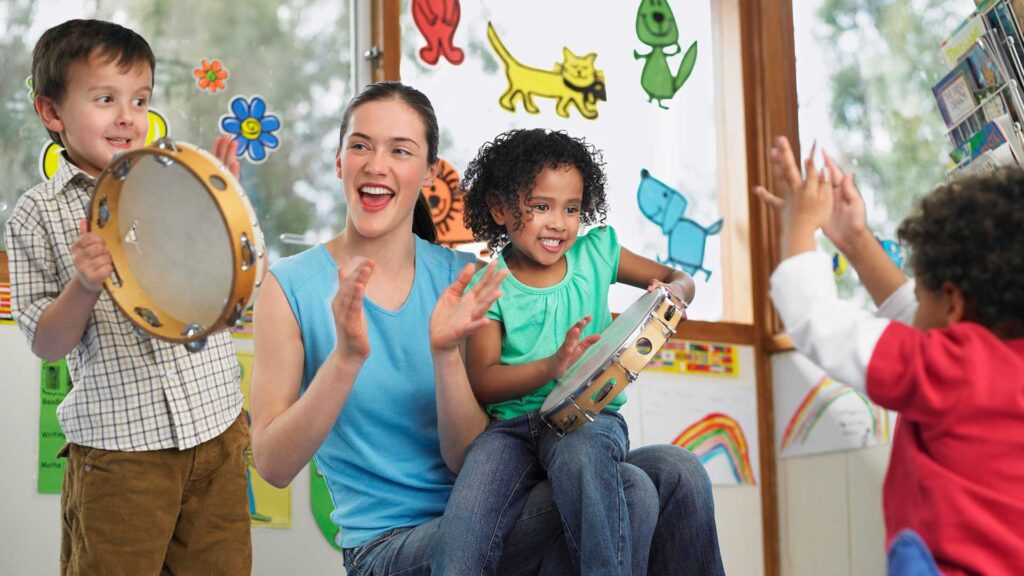Table of Contents
How does music therapy help autism?
As parents, we are always looking for the best for our children, especially when they face unique challenges such as autism spectrum disorder (ASD). The relationship between music therapy and autism has caught the attention of many parents who explore various therapies and approaches that can help their little ones develop and connect with the world around them.
Music therapy for autism spectrum disorder represents an evidence-based therapeutic intervention with significant results in the development of social, communication, and emotional skills.
Music therapy interventions have gained recognition for their ability to create meaningful connections and promote holistic development. Music, as a universal language, offers a structured and predictable medium that is particularly beneficial for individuals on the spectrum.
When parents inquire about music therapy and autism, they may ask: How does music therapy help autism? Scientific research has documented that music stimulates multiple brain areas simultaneously, facilitating improvements in communication, emotional expression, and social skills. Studies show that music therapy interventions for autism generate significant gains in critical areas such as joint attention, social reciprocity, and emotional self-regulation.
In this ABA Centers of New Jersey blog, we will delve into the relationship between music therapy and autism, explore its benefits, and how parents can integrate music into the lives of their little ones with autism.
Understanding Music Therapy and Autism
Music can be a powerful tool for meeting the cognitive, emotional, and social needs of children with autism. According to the International Journal of Environmental Research and Public Health, many children on the spectrum find music a means to regulate their emotions and strengthen their social interactions. They often show a preference for music over verbal language, noted for superior tonal memory and a particular appreciation for dissonant sounds.

From a physiological perspective, children with autism tend to respond to music more strongly than their neurotypical peers. They prefer predictable, upbeat melodies, which activate areas of the brain linked to happiness. For some, the rhythmic structure of music offers them a sense of stability and security. For others, the emotions conveyed through rhythm and melody are more straightforward to interpret than those expressed in words, making music a bridge to communication and well-being.
Music therapy is based on the premise that we all have an innate response to music, regardless of our abilities or challenges. In the context of autism, music therapy is tailored to the individual needs of each child, using musical elements to address specific areas such as communication, social skills, and emotional regulation.
Numerous scientific investigations support the effectiveness of music therapy. A meta-analysis published in Cochrane Library analyzed 10 studies with a total of 165 children with autism to see how music therapy affected them in the short and medium term. They compared music therapy with other “placebo” or standard care therapies.
The results showed that music therapy was better in several key areas:
- Helping kids interact socially during therapy
- Improving their ability to interact socially outside of therapy
- Strengthening their non-verbal communication skills (like gestures and eye contact) during therapy
- Enhancing their verbal communication skills
- Encouraging them to take initiative in social situations
- Improving their ability to engage emotionally with others

Music therapy also had positive effects on other areas, such as:
- Helping children adapt socially
- Increasing their feelings of joy
- Strengthening the relationship between parents and children
Delving Into the Benefits of Music Therapy for Autism Spectrum Disorder
- Communication and Language: Many children with ASD face difficulties in verbal communication. Music, with its predictable and repetitive structure, can serve as an alternative or supplement to spoken language. Through songs, rhythms, and musical games, therapists can encourage imitation of sounds, articulation of words, and language comprehension.
- Social Skills: Social interaction can be a challenge for children with autism. Music therapy provides an environment where therapists encourage joint participation, turn-taking, and cooperation. Activities such as playing instruments in a group or singing together can help children develop greater awareness of others and practice social skills in a safe and fun context.
- Emotional and Behavioral Regulation: Music can evoke and regulate emotions. For children with autism, who often experience difficulty managing their emotions, music therapy can be an effective tool for identifying, expressing, and controlling feelings. Through musical improvisation and guided listening, children can explore their emotions and learn strategies for self-regulation.
A study published in Frontiers in Psychology found that music therapy reduced disruptive behaviors and improved emotional regulation in children with ASD. The authors suggest that the structure and predictability of music provide a safe framework for children to explore and manage their emotions.
4. Motor Skills and Coordination: Learning to play instruments and dance can help strengthen the fine and gross motor skills of children with ASD. In music therapy interventions for autism, children participate in activities such as clapping, drumming, and dancing within a structured and friendly environment to practice motor control, hand-eye coordination, and balance.

Music Therapy Interventions for Autism
Several music therapeutic interventions can address the needs of children with ASD. The following are some of the most common:
- Musical Improvisation: Improvisation allows children to express themselves freely through sounds and rhythms without the pressure of following a predefined structure. This technique encourages creativity and can serve as an avenue for nonverbal communication.
- Personalized Songs: Creating songs tailored to the child’s experiences and preferences can facilitate learning new skills or concepts. For example, a song about hand washing can help establish daily hygiene routines.
- Rhythmic Games: Games that incorporate rhythms and movements, such as passing a ball to the beat of a song, can improve motor coordination and encourage social interaction.
- Active Listening: Listening to different types of music can be used to explore and recognize emotions, as well as to promote relaxation and attention.
Incorporating Music in the Home
As parents, we can also integrate music into our children’s daily lives to complement professional therapy. Here are some practical music therapy for autism spectrum disorder techniques that parents and caregivers can incorporate at home:
- Musical Routines: Incorporating songs into daily routines, such as a wake-up tune or a bathtime song, can provide structure and predictability.
- Instrument Exploration: Providing simple instruments, such as drums or maracas, allows children to explore sounds and rhythms freely.

- Family Singing Sessions: Singing together strengthens family bonds and provides a chance to practice communication skills in a familiar setting.
- Dance and Movement: Dancing to your child’s favorite music can improve coordination and provide an outlet for pent-up energy.
ABA Centers of New Jersey Helps Children with Autism Develop
At ABA Centers of New Jersey, we know that children with ASD may need personalized, comprehensive support to develop essential life skills. Music therapy and autism make a fantastic team. By combining the inherent structure of music with the flexibility of personalized interventions, this therapy can address diverse areas of need, from communication to emotional regulation.
Therapies such as music therapy and applied behavior analysis (ABA therapy) are two methodologies that together provide valuable support for children with autism to reach their developmental milestones. While ABA therapy is the gold standard for autism care, helping individuals develop skills in communication, social, regulation, and more, music therapy is the ideal complement to support and strengthen the learning of these skills from an artistic perspective.
At ABA Centers of New Jersey, we recognize that complementary therapies such as music therapy can provide powerful additional benefits.
To understand more about ABA therapy and complementary therapies for autism, call us at (855) 640-7888 or complete our online form. Our goal is to help you find the comprehensive approach that will most benefit your little one with autism!








